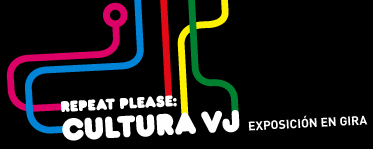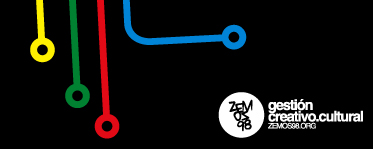VJ Culture: From Loop Industry To Real Time Scenarios
2003 was the breakthrough year for VJ culture and the hype seems to continue. This year D-FUSE and Lumens will publish a major VJ book — canonizing trends in ink and paper. VJ communities are growing; building their own networks and organizing VJ festivals where artists come together to display their latest work and debate over the future of VJing at roundtable discussions. While ever more available venues and tools for performance make that future so brilliant and near, the newness of the culture denies the past from feeling much beyond contemporary.
In the early days of MTV, fresh faces called video jockeys presented music videos from the latest pop acts. Some of them became famous by hosting their own shows on television. The rise of MTV from clever entrepreneurship to cultural staple put the term VJ in the American Heritage Dictionary. Today the term VJ refers to video performance artists that create live visuals in tandem with different styles of music in various environments rather than a talking head.
NYC based VJ Benton C. Bainbridge explains the transition from buzz-word to artist:
“Coincidentally, the year 2000 is when I noticed an explosion of interest in live video and visuals in general. Before 2000, when I told people I make video live, I would get a blank uncomprehending stare. Now I tell people I make video live, and they say, ‘of course, so you’re a VJ’“.
Even though the term has become popular in this context only recently, audiovisual performance emerged with the beginning of human culture. VJ Flunchtpunkt claims that even the Lascaux caverns were basically remnants of prehistoric raves, parties with visuals before technology. More recently, trippy projections, Mark Boyle’s light shows in London’s UFO club of the 60’s, and the 70’s psychedelic fractals played a formative role in underground culture. Seemingly, man has long held an interest in projecting visual images, reversing the act of seeing, or making their dreams real.
The varied approaches to live visual manipulation reflect the history and diversity of individuals practicing the art. Styles range from highly technical and refined to easy, lower fidelity as performers utilize tools ranging from game consoles and laptops to complicated miniature theaters to cast their projections. Despite that variability, a certain collective lexicon of imagery, themes, and technique has emerged. VJ’s commonly mobilize the gaze, implying continuous camera motion to produce a traveling sensation and mimic hallucinogenic experiences with nonlinear abstraction, piling and manipulating images as though it were sound. VJ’s project the stories of the contemporary culture; juxtaposing fragments culled from TV, videos, movies, magazines, animations, games, video art, politics, etc. to prey upon and recontextualize the huge visual manipulation we experience in the everyday.
Access to more, and more portable, tools allows a greater variety of artists entry to this brand of storytelling and has helped expand and proliferate the VJ community. “The VJ scene is exploding in large part due to the accessibility of ever more powerful and cheaper tools like digital camcorders and realtime laptop applications,” Benton says. The change from analogue to digital environment has also enabled VJs to travel lightly. Bulky equipment, such as VHS video-players, video mixing tables, monitors, and projectors have been replaced by laptops and some cables, and most clubs have already installed the technical setup necessary for visual performances.
Along with smaller, faster laptops there is also a huge variety of VJ software to choose from. Audio-visualizers, one of the biggest webportals for VJs, list over one hundred applications on their site. The style of VJing goes hand in hand with the program. Basic applications like Arkaos or Resolume utilize the keyboard to alternate between a gallery of videoclips or external sources and add some funky effects. Recently there has been a shift to more complicated modular applications like Nato.0+55, Jitter, or Puredata allow VJ’s to program their own effects and mix and alter so-called video objects. This variety of program brings VJing closer to programming or digital design by allowing artists to generate visuals without external inputs. Networking software like Keyworx allows disparate participants to send images which can be mixed in a live visual jam.
As a result of such development in electronic communication, jamming and interaction have become essential activities within VJ culture. VJ communities like SAT in Montreal invite VJ’s from various countries to send visual streams via internet and then rebroadcast them in realtime to any PC with internet access. They have also collaborated with universities like UPC in Barcelona to experiment with internet2 who’s larger1GB bandwidth is better suited to transmitting video material. Jamming has also found an outlet at New York’s Share club where sound and visual creators gather weekly to plug in and improvise together.
This transcontinental exchange has produced interesting results. “As VJing has become a global movement, ironically we are becoming more factious within our little sub-scenes and regions, the scene splintering into styles much like electronic dance music. I’ve found that certain aesthetics dominate regions- real world imagery rules London, Berlin visuals tend to be minimal, hard edged and urban while the San Francisco Bay Area mixes are often psychedelic, swirly and colorful,” Benton explains.
Naturally, there has been a parallel development between visual aesthetics and the music VJ’s tend to accompany. In club environments, visuals often act as music videos made live dialogue with a DJ. Cool sexy graphics lend themselves to house, while techno and electro suggest harder and more minimalist imagery. Club VJ’s face the challenge of interweaving visuals with an unknown sonic ambiance and an unpredictable dance-floor, often limiting the communication between VJ and DJ to questions of style.
In response, some budding VJ’s have formed groups in tandem with musicians. These A/V collectives produce performances where the interaction between image and sound elevates to higher levels. New York’s 242.pilots, Vienna’s Farmers Manual, Brussels’ Visual Kitchen, London’s Slub effectively blur the division between sound and image to critical acclaim and public pleasure. This exposure has lead to increased respect for audiovisual performances. Last year 242.pilots won the Golden Award in the image category at Transmediale media festival in Berlin. Other video and film festivals have added experimental categories to include DVD’s and offer live performances in their programs. Audiences have come to crave new audiovisual experiences, but artists continue to need places with technical support to show their work. In Brussels Nico Wierinck, the promoter and founder of Cimatics, is organizing special events for audiovisual performances to meet those needs:
“The idea to organize a VJ festival was rather simple; we had some good Belgian VJ’s and no specific promotional platform here in Belgium. … VJ pioneers such as Coldcut, Hexstatic or Visual Kitchen gave me a big impulse. And I was really impressed by Exceeda’s live shows. We wanted to put a program together who could give a complete overview of VJ culture around the world — DJ/VJ sets, A/V performances, live cinema, screenings, talks, DVD labels and workshops. The project has been well received since the beginning, [which] was really motivating. I think there was really a demand from the artists.”
American DJ Samira echos Wierinick’s optimism as she explains the impetus for adding a VJ section to Sister SF, a website devoted to promoting female DJ’s:
“It recently dawned on me that I couldn’t think of any female VJ’s; moreover, I couldn’t really remember very many instances when I’ve seen women do the visuals at clubs and parties. I know they’re out there but, as with DJing, there are fewer women who VJ than there are men. And I’d actually like to start working with some VJ’s and be able to provide female VJ’s to show off their talent. So, the new VJ section on the Sister SF site is the beginning of that.”
The London based design collective D-Fuse plan to publish a book on Vjing this year with hopes of bringing VJ culture more into the mainstream and help produce a more professional and organized community. Dina argues that this type of publication is necessary to the future of Vjing:
“Audio/Video based performances is now often expected. The VJ scene has been growing very fast especially in Eastern Europe and Japan. …It has now entered the advertisement world. But the problem is that this scene is run by amateurs, and unless it develops a solid platform, the whole thing could implode. Sadly here are too many ‘makeshift’ disorganised VJ’s. But you get this sort of happen in all scenes. Big Fish in a small pond. The VJ scene has to migrate to the mainstream in order to expand. We feel the book is so important; this will set an imprint and establish the scene.“
Despite the increased activity and publicity, very few VJ’s make a living by VJng. Most internationally recognized VJ’s achieve notoriety as artists or designers initially. Even in Japan where VJing has gained considerable mass interest, very few avowed artists have emerged from a large and competitive field. As virtually no market exists for mix DVD’s, VJ’s (unlike DJ’s who can sell mix tapes or CD’s) must rely on live performances to share their work with the public.
Nonetheless, the VJ community envisions a bright future. At the AVIT VJ event in Brighton, England, VJ Anyone spoke of VJing as a religion — a place where young people in the near future will gather for ceremonies. VJ Johnny DeKam has actually sold his VJ software to religious groups in southern states. The days-long audio-visual flow witnessed at free parties in Spain draw up spiritual comparisons indicating that VJ’s and DJ’s have begun to play roles of priests and shamen for the post-MTV generation.
Yet, with increasingly frequent development roles scarcely solidify that firmly. Nico from Cimatics foresees that MJ’s (media jammers or jugglers), who control both the audio and video will, overpass VJ’s. Benton calls for physical interfaces for visual tools like immersive network display technologies. He continues, “what we now call VJing will mutate and become a basic skill that everyone at least dabbles in, like doodling, learning an instrument or keeping a journal. Though at that point, a VJ may more resemble a video game player in a chat session. I’m most excited by the possibilities of VJing as everyday communication and self-expression; a natural evolution for today’s kids who learn computers before they can read and write. A 9 year-old girl sitting next to me gave me the most perceptive analysis of my craft after 15 minutes of looking at my analog a/v synthesis work on my laptop.“
Johnny and Nico’s claims may prove a bit lofty, but during a recent workshop in Barcelona, over 20 people gathered around a huge table keeping up the stream of images and sound for hours. Nobody had time to notice whether there was audience or not; and in the end it didn’t really matter; performing live together was such a great feeling. ?
Mia Makela (a.k.a SOLU) is finnish media+live cinema artist, teacher, investigator and cultural activist
residing in Barcelona.


Leave a Reply
You must be logged in to post a comment.